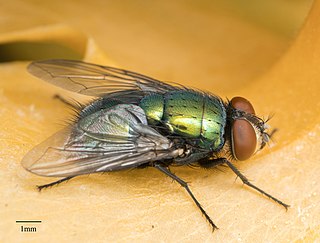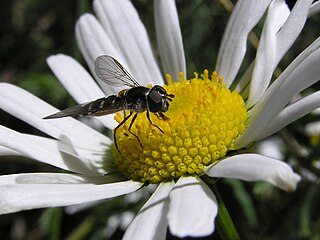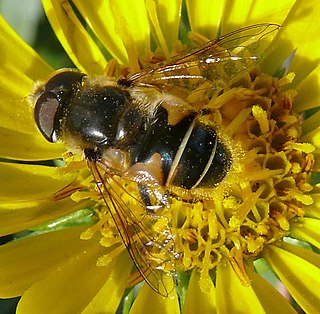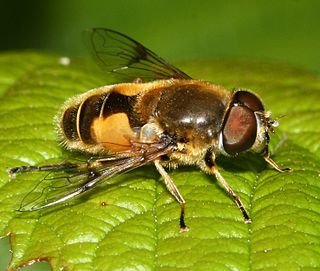
Flies are insects of the order Diptera, the name being derived from the Greek δι- di- "two", and πτερόν pteron "wing". Insects of this order use only a single pair of wings to fly, the hindwings having evolved into advanced mechanosensory organs known as halteres, which act as high-speed sensors of rotational movement and allow dipterans to perform advanced aerobatics. Diptera is a large order containing an estimated 1,000,000 species including horse-flies, crane flies, hoverflies, mosquitoes and others, although only about 125,000 species have been described.

Hover flies, also called flower flies or syrphid flies, make up the insect family Syrphidae. As their common name suggests, they are often seen hovering or nectaring at flowers; the adults of many species feed mainly on nectar and pollen, while the larvae (maggots) eat a wide range of foods. In some species, the larvae are saprotrophs, eating decaying plant and animal matter in the soil or in ponds and streams. In other species, the larvae are insectivores and prey on aphids, thrips, and other plant-sucking insects.

Myiasis, also known as flystrike or fly strike, is the parasitic infestation of the body of a live animal by fly larvae (maggots) that grow inside the host while feeding on its tissue. Although flies are most commonly attracted to open wounds and urine- or feces-soaked fur, some species can create an infestation even on unbroken skin and have been known to use moist soil and non-myiatic flies as vector agents for their parasitic larvae.

The common green bottle fly is a blowfly found in most areas of the world and is the most well-known of the numerous green bottle fly species. Its body is 10–14 mm (0.39–0.55 in) in length – slightly larger than a house fly – and has brilliant, metallic, blue-green or golden coloration with black markings. It has short, sparse, black bristles (setae) and three cross-grooves on the thorax. The wings are clear with light brown veins, and the legs and antennae are black. The larvae of the fly may be used for maggot therapy, are commonly used in forensic entomology, and can be the cause of myiasis in livestock and pets. The common green bottle fly emerges in the spring for mating.

Eristalis is a large genus of hoverflies, family Syrphidae, in the order Diptera. Several species are known as drone flies because they bear a resemblance to honeybee drones.

Rat-tailed maggots are the larvae of certain species of hoverflies belonging to the tribes Eristalini and Sericomyiini. A characteristic feature of rat-tailed maggots is a tube-like, telescoping breathing siphon located at its posterior end. This acts like a snorkel, allowing the larva to breathe air while submerged. The siphon is usually about as long as the maggot's body, but can be extended as long as 150 mm (5.9 in). This organ gives the larva its common name.

Bombylius major is a parasitic bee mimic fly. B. major is the most common type of fly within the Bombylius genus. The fly derives its name from its close resemblance to bumblebees and are often mistaken for them.

Eristalinae are one of the four subfamilies of the fly family Syrphidae, or hoverflies. A well-known species included in this subfamily is the dronefly, Eristalis tenax.

Eristalis arbustorum, the European drone fly, is an abundant Northern Hemisphere species of syrphid fly, originally officially described by Linnaeus in 1758 as Musca arbustorum. The name "drone fly" is related to its similar appearance to the drone of the honeybee. Hoverflies get their names from the ability to remain nearly motionless while in flight. The adults are also known as flower flies as they are commonly found on and around flowers from which they get both energy-giving nectar and protein rich pollen. The larvae are aquatic filter-feeders of the long-tailed type.

Syritta pipiens, sometimes called the thick-legged hoverfly, is one of the most common species in the insect family Syrphidae. This fly originates from Europe and is currently distributed across Eurasia and North America. They are fast and nimble fliers, and their larvae are found in wet, rotting organic matter such as garden compost, manure, and silage. The species is also commonly found in human-created environments such as most farmland, gardens, and urban parks, wherever there are flowers. This species is an important part of its native ecosystem as adult Syritta pipiens flies are critical pollinators for a variety of flowering plants and the species supports parasitism by various parasitic wasp species. Thus, they play an important role in environmental functionality, and can serve as bio-indicators, in which their abundance can reflect the health of the environment. Syritta pipiens looks like many predatory hoverfly species, yet is not predatory.

Toxomerus is a very large genus of hoverflies. They are found in many parts of North and South America. Most larvae are predators on soft bodied insects, though a few species have been shown to feed on pollen. Adults feed on the pollen of a wide range of flowers.

Sericomyia chrysotoxoides ,, the Oblique-banded Pond Fly , is a common species of syrphid fly observed across the eastern half of North America and in the Rocky Mountains. Syrphid flies are also known as Hover Flies or Flower Flies because the adults are frequently found hovering around flowers from which they feed on nectar and pollen. Adults are 9.6–1,315.3 mm (0.38–51.78 in) long, black with yellow bands, less prominent in the male. The larvae of this genus are known as rat tailed maggots for the long posterior breathing tube.

Eristalini is a tribe of hoverflies. Several species are well-known honeybee mimics, such as the drone fly Eristalis tenax, while other genera such as Helophilus and Parhelophilus exhibit wasp-like patterns of yellow and black stripes, both strategies to avoid predation by visual predators such as birds.
Diptera is an order of winged insects commonly known as flies. Diptera, which are one of the most successful groups of organisms on Earth, are very diverse biologically. None are truly marine but they occupy virtually every terrestrial niche. Many have co-evolved in association with plants and animals. The Diptera are a very significant group in the decomposition and degeneration of plant and animal matter, are instrumental in the breakdown and release of nutrients back into the soil, and whose larvae supplement the diet of higher agrarian organisms. They are also an important component in food chains.

Melangyna novaezelandiae is a hoverfly endemic to New Zealand. It is a generalized pollinator of a large range of plants that are both native and exotic to the New Zealand flora. M. novaezelandiae is widespread throughout New Zealand, including in agricultural environments. The larvae of this species feeds on other arthropods and may have uses as a biocontrol agent.

Spilomyia longicornis is a species of syrphid fly, also known as a flower fly or hoverfly, in the family Syrphidae. Although the appearance of S. longicornis is remarkably similar to a vespid wasp, it is a fly and cannot sting. It occurs in North America, east of the Rocky Mountains.

Eristalis bellardii, the Mexican mountain drone fly, is an uncommon species of syrphid fly first officially described by Jaennicke in 1867. It is infrequently found in the Southwestern United States, Mexico and Central America. In appearance it is somewhat like that of a honeybee. Hoverflies get their names from the ability to remain nearly motionless while in flight. The adults are also known as flower flies for they are commonly found around and on flowers, from which they get both energy-giving nectar and protein-rich pollen.

Eristalis hirta, the black-footed drone fly, is a common Western North American species of syrphid fly, first officially described by Loew in 1866. Hoverflies get their names from the ability to remain nearly motionless while in flight. The adults are also known as flower flies as they are commonly found on and around flowers, from which they get both energy-giving nectar and protein-rich pollen. The larvae are aquatic filter-feeders of the rat-tailed type.

Eristalinus tabanoides is a species of hoverfly that inhabits the Old world.

Eristalina is a subtribe of hoverflies with 17 genera. Several species are well-known bee mimics, such as the drone fly. The larvae live in aquatic and moist organic material, often with low oxygen levels using a posterior breathing tube, thus the common name—the "rat-tailed maggot".


























